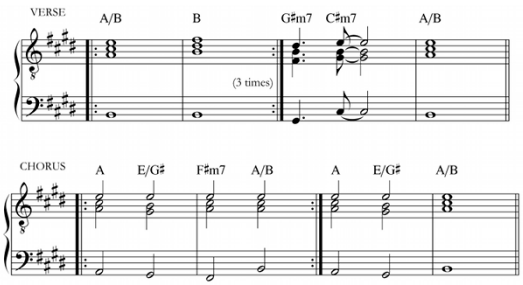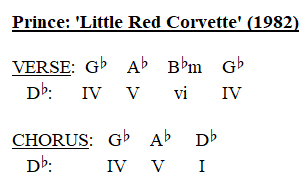|
The other day I blogged about my intent to "post summaries and reviews of articles and books by authors who have written about those 'purely musical achievements'." This will be the first such post. Mark Spicer is professor of music at Hunter College in New York, NY. He published an article in Music Theory Online last year in which he cites three examples of how pop musicians “toyed with tonality” by citing “three tonal scenarios”. This blog will summarize Spicer's main points and examples. I will close by relating his ideas to the catalog I know best: The Beatles. The first scenario Spicer considers are fragile tonics, which he defines as “the tonic chord is present but its hierarchical status is weakened”. Among other examples, Spicer cites Hall and Oates' 'She's Gone' (1973). The song is in E major, however the tonic chord is conspicuously absent from the verses, and appears only fleetingly (as a first-inversion passing chord on a week beat) in the choruses. This weakened tonic often corresponds to the lyrics, as is the case in Hall and Oates' 'She's Gone' (1973), in which the fragile tonic reflects the singer's fragile emotional state following a break-up: My face ain't looking any younger Now I can see love's taken her toll on me. She's gone. I 'd better learn how to face it. She's gone. I'd pay the devil to replace her. She's gone. What went wrong? The second tonal scenario are emergent tonics, in which “the tonic chord is initially absent yet deliberately saved for a triumphant arrival later”. Spicer cites Prince's 'Little Red Corvette' (1982) as an example. The tonic D-flat major chord, absent from the verses, emerges in the choruses, "where it serves as a metaphor for the release of the sexual tension built up in the preceding verse." Third are absent tonics, in which "the promised tonic chord never actually materializes.” Obviously this third category is the most difficult to discern for the reason that tonic is never heard - the song's harmony must convincingly imply tonic without actually giving it. From a compositional standpoint, this is tough to do (or at least it's difficult to do well); and from an analytic standpoint, it's heavily dependent on interpretation (how convincingly is tonic implied?). Spicer provides the example of 'Jane Says' (1988) by Jane's Addiction. The entire song consists of just two vacillating G and A chords, yet the song is clearly in D (judging from the sung melody). The tonic D major chord, then, is entirely absent - never heard, not even once, throughout the nearly-five-minute song. So there are Spicer's three categories of fragile, emergent, and absent tonics. How do The Beatles fit into these categories?
Well, the short answer is: They don't! The Beatles tend to be very clear about their tonics, and it's extremely rare to find a section of any given song (much less an entire song) with a fragile, emergent, or absent tonic. John Lennon's 'Glass Onion' (1968) is the sole exception. Lennon said about it: “I was just having a laugh, because there had been so much gobbledegook written about Sgt. Pepper. People were saying, 'Play it backwards while standing on your head, and you'll get a secret message.' … I threw the line in – 'The Walrus was Paul' – just to confuse everybody a bit more" (Dowlding, page 225; Sheff, page 208). So the lyrics aren't supposed to make sense! And indeed, the harmony (appropriately) doesn't make sense, either. In BEATLESTUDY, I analyzed it three different ways: in C major, in A minor, and in F major. None of those three fit perfectly, but between the three I think I covered it pretty well. The only cadences in 'Glass Onion' are the g-C-F progressions (ii-V-I in F major) heard from 0:15-0:19, 0:44-0:49, and 1:34-1:38; and the F-G-a progressions (bVI-bVII-i in A minor) heard from 0:27-0:31, 0:57-1:01, and 1:16-1:20. But if I had to pick "the best tonal interpretation", I'd probably chose C major, even though there are no cadences to confirm that tonality. In fact, every time a potential cadence builds (every time we hear a strong predominant followed by a strong dominant), that expectation is thwarted by meandering harmony. So I think the best interpretation of 'Glass Onion' is with the absent tonic of C major. REFERENCES
0 Comments
Leave a Reply. |
Aaron Krerowicz, pop music scholarAn informal but highly analytic study of popular music. Archives
August 2019
Categories
All
|


 RSS Feed
RSS Feed
